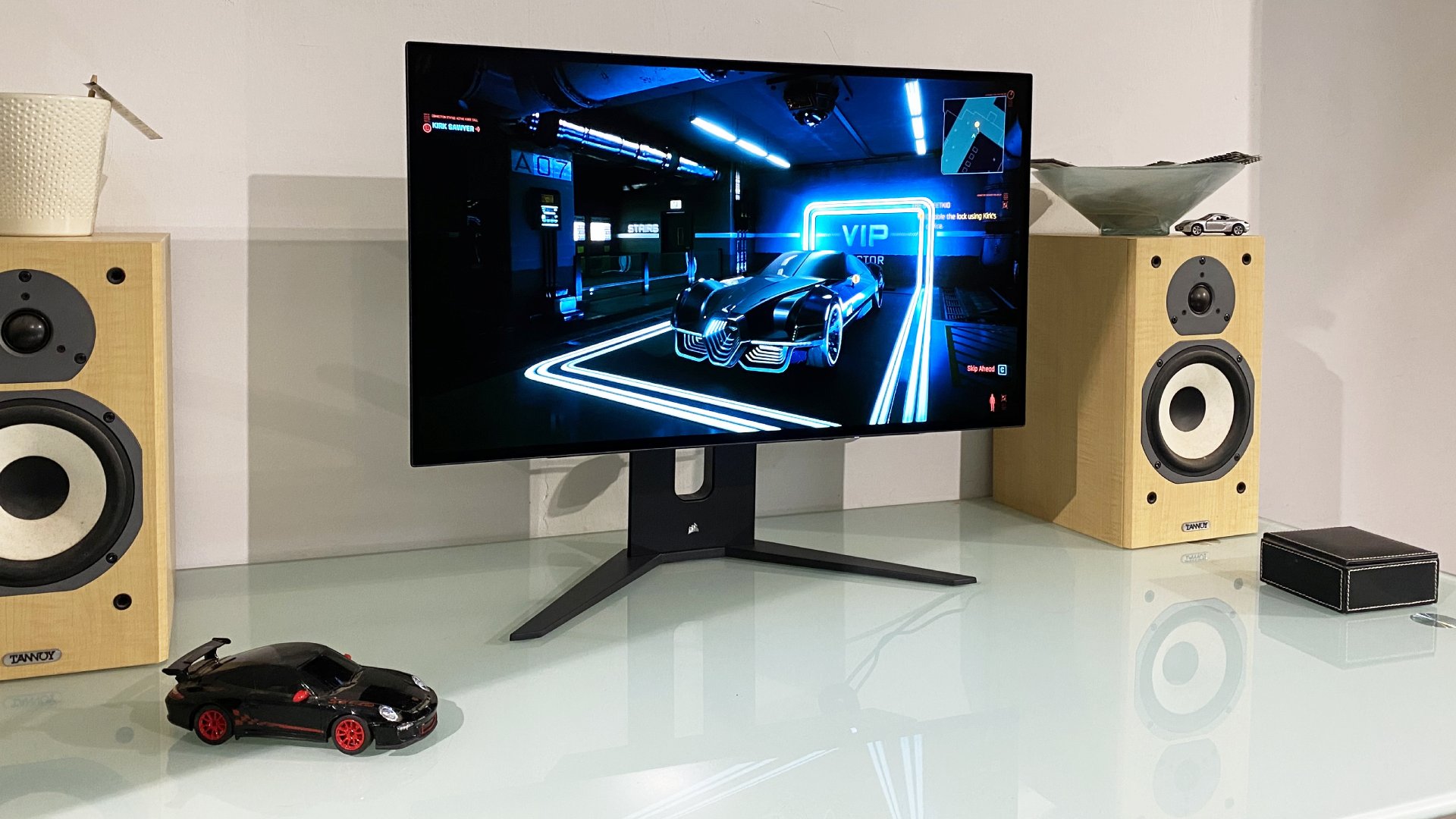Our Verdict
Corsair's take on the 27-inch 1440p OLED is beautifully engineered and all the usual LG-powered OLED upsides appear, including warp-speed responses and lovely per-pixel lighting. But so does the inconsistent brightness. And that's a little tricky to accept at this lofty price point.
For
- Outrageous pixel response
- Per-pixel OLED lighting
- Nicely engineered
Against
- Inconsistent brightness
- Very expensive for a 27-inch panel
PC Gamer's got your back
Be careful what you ask for, because you might just get it. Well, we asked for OLED on the desktop, and boy are we getting it. The latest entrant in the burgeoning OLED gaming monitor market is the new Corsair Xeneon 27QHD240, the latest of a growing subsection of 27-inch 1440p OLEDs running at 240Hz.
There's one key question. No, not will it burn in, but is it bright enough?
Like all the others, including LG's own UltraGear 27GR95QE-B and the Asus ROG Swift OLED PG27AQDM, the Corsair Xeneon 27QHD240 runs an LG WOLED panel. With that comes plenty of characteristic OLED goodness, which we'll come to in a moment.
But it also brings one key question. No, not will it burn in, but is it bright enough? LG's OLED panels have proven a little problematic in a desktop PC context when it comes to full-screen or nearly full-screen brightness.
It's one metric by which Samsung's competing QD-OLED panels, as seen in the fantastic Alienware 34 AW3423DWF, have a clear advantage. They're just better at basic brightness.
Not that you'd know from the claimed specs. Like pretty much every OLED gaming monitor, Corsair rates the Xeneon 27QHD240 at 1,000 nits peak brightness in a 3% window. That drops to 800 nits for a 10% window. What Corsair doesn't quote is full-screen brightness.
Thus far, monitors with LG OLED panels have tended to be around 150 nits full screen, with the Samsung QD-OLED brigade nearer 250 nits. That's a very noticeable delta. And it's not just outright brightness that's the problem.
With LG-powered OLED monitors, including Corsair's own Xeneon Flex, you can very obviously see the entire brightness of the panel changing depending on what's being rendered. Let's say you are looking at the Windows desktop showing a dark wallpaper. Then open a web browser with a white background that covers much of the screen.
The result with every LG OLED monitor panel we've seen thus far is a big drop off in brightness. Unfortunately, that remains the case here. The automatic brightness limiter (ABL) kicks in and the panel dims dramatically.
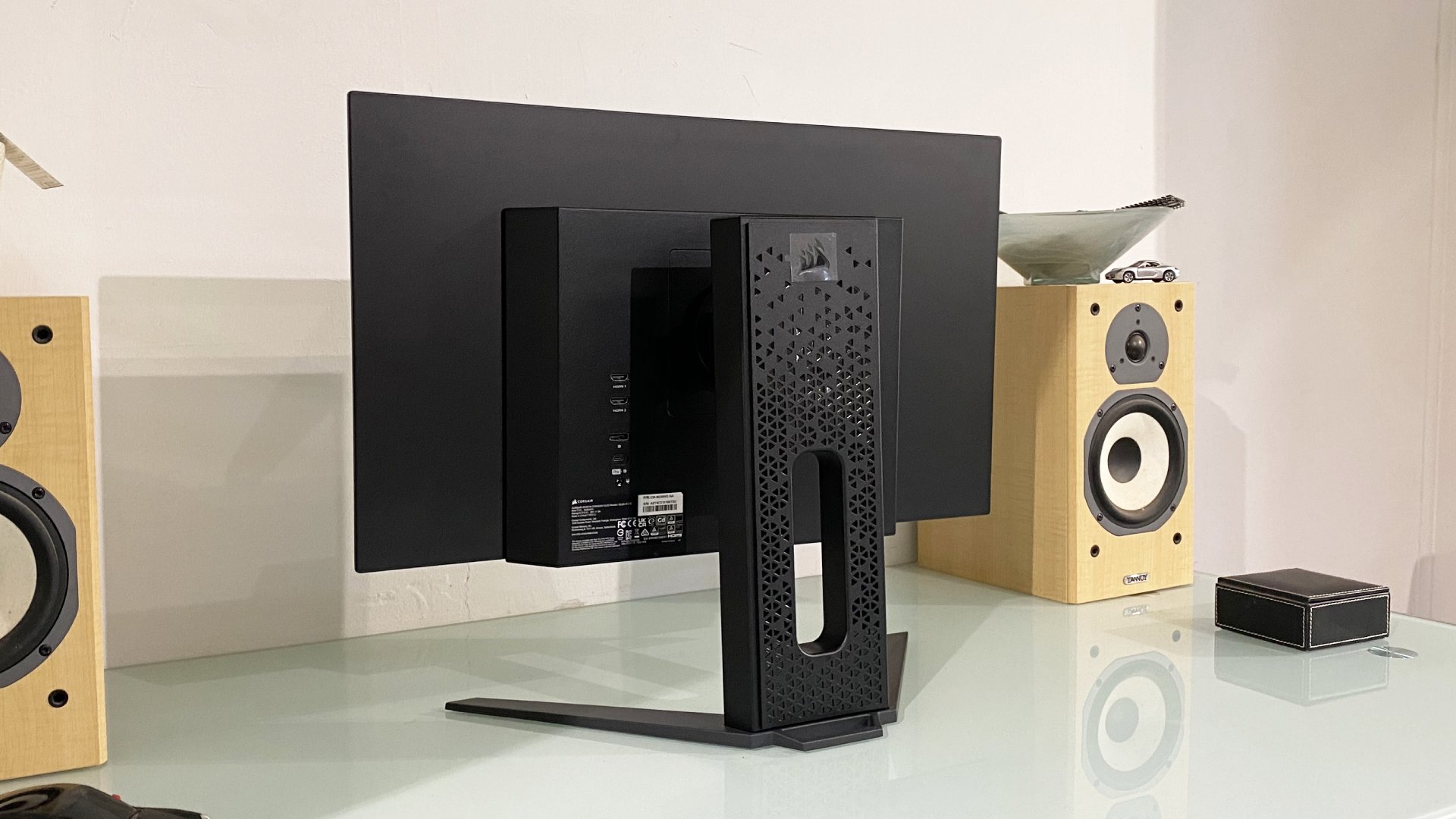
Yes, you can disable the ABL. But then everything looks dark and dingy all the time. The caveat to all this is that the problem is much more noticeable on the Windows desktop than it is playing games.
The brightness jumping around in-game isn't a major distraction. What is more noticeable is the lack of punch in brighter outdoor gaming scenes. Like all LG-derived OLED gaming monitors, the Corsair Xeneon 27QHD240 simply lacks zing in those scenarios.
Again, the Xeneon absolutely isn't unique in that regard, so it's not a fault of Corsair itself. Full-screen or nearly full-screen brightness is a weakness with all LG-enabled OLED gaming monitors thus far. But it is still an issue, especially for such an expensive monitor.
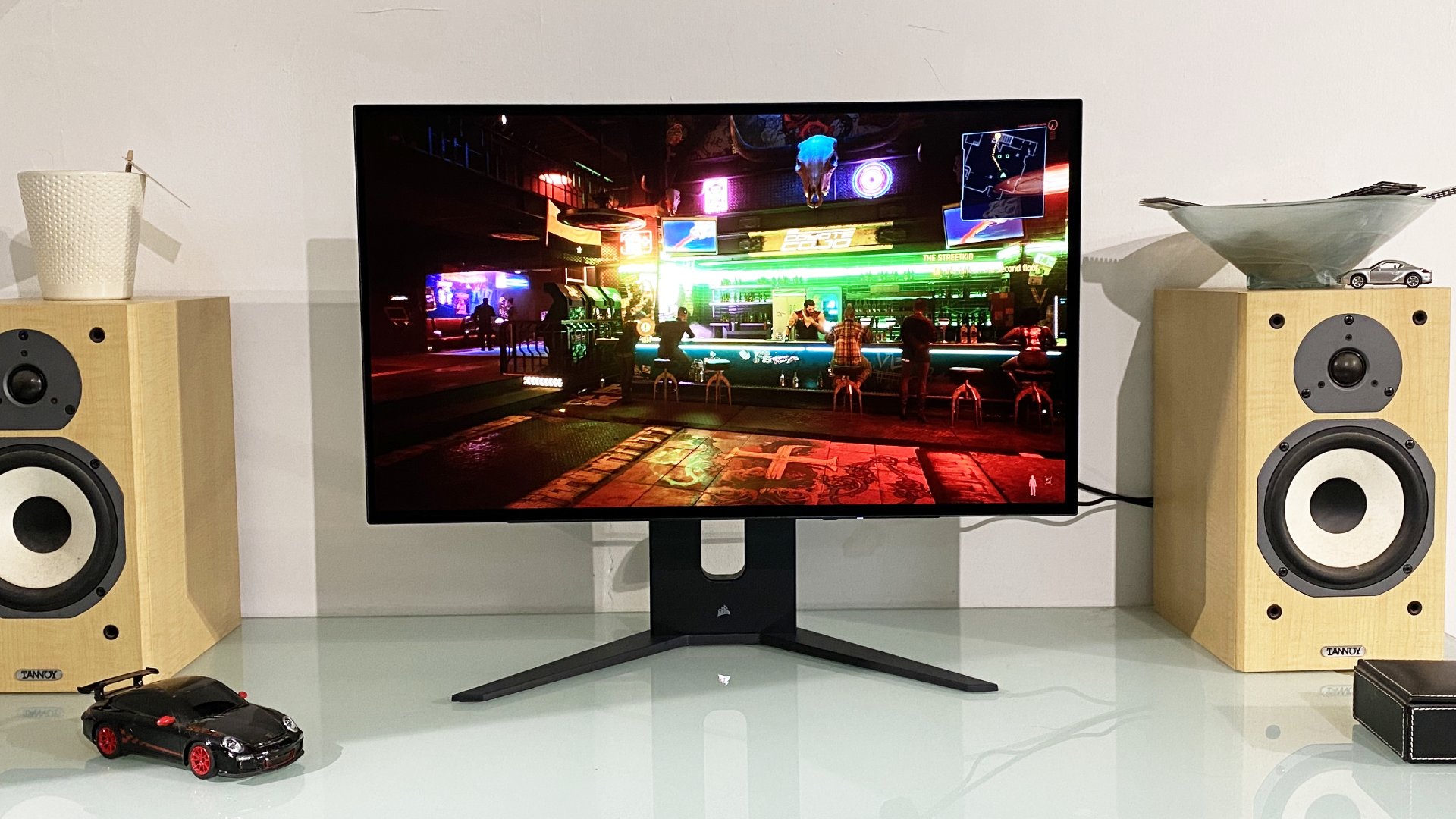
Elsewhere, however, it's mostly very good news. In darker scenes punctuated by smaller bright objects, this monitor really delivers. That end of the HDR experience spectrum seriously sizzles, even if the matte anti-glare coating does very slightly compromise black levels. You can keep your Mini LED monitors, they can't compete with the per-pixel lighting on offer here.
You can keep your Mini LED monitors, they can't compete with the per-pixel lighting on offer here.
They can't keep up with the pace of the Corsair Xeneon 27QHD240's pixels, either. LCD tech has improved dramatically when it comes to response in recent years, but it's still an order of magnitude slower than the silly-fast performance of OLED.
You can see that playing shooters. There's just no unintentional blurring. Add in the 240Hz refresh, and you have both no blur and super low latency. This really is a killer display for, well, killing enemies.

What it's less convincing at is serving up a really exceptional visual spectacle. Partly that's down to size. OK, at around $1,000 this monitor is priced very much on par with similar OLED options, but it's still an absolute hill of money for a 27-inch 1440p gaming monitor.
That makes for a tricky comparison compared to, say, a 34-inch ultrawide monitor. You can actually have one of those with a Samsung QD-OLED panel for barely any more money. Sure, the Alienware 34 AW3423DWF only runs at 165Hz, but most of the time you'll barely notice that.
$1,000 also buys you all manner of fully 4K LCD gaming panels, some with Mini LED backlights and local dimming. The HDR experience and pixel speed won't compete with the Corsair, but the image detail from 4K is on another level.
The pixel speed and latency are just fabulous.
Granted, this monitor's 1440p native resolution helps keep the frame rates up. But surely anyone who can afford a $1,000 OLED monitor can also stump up for a premium graphics card capable of good frame rates at 4K, no?
There's a lot to like about this monitor, then. The pixel speed and latency are just fabulous. In certain scenarios, the HDR experience is fantastic, too. The build quality and features are super, too.
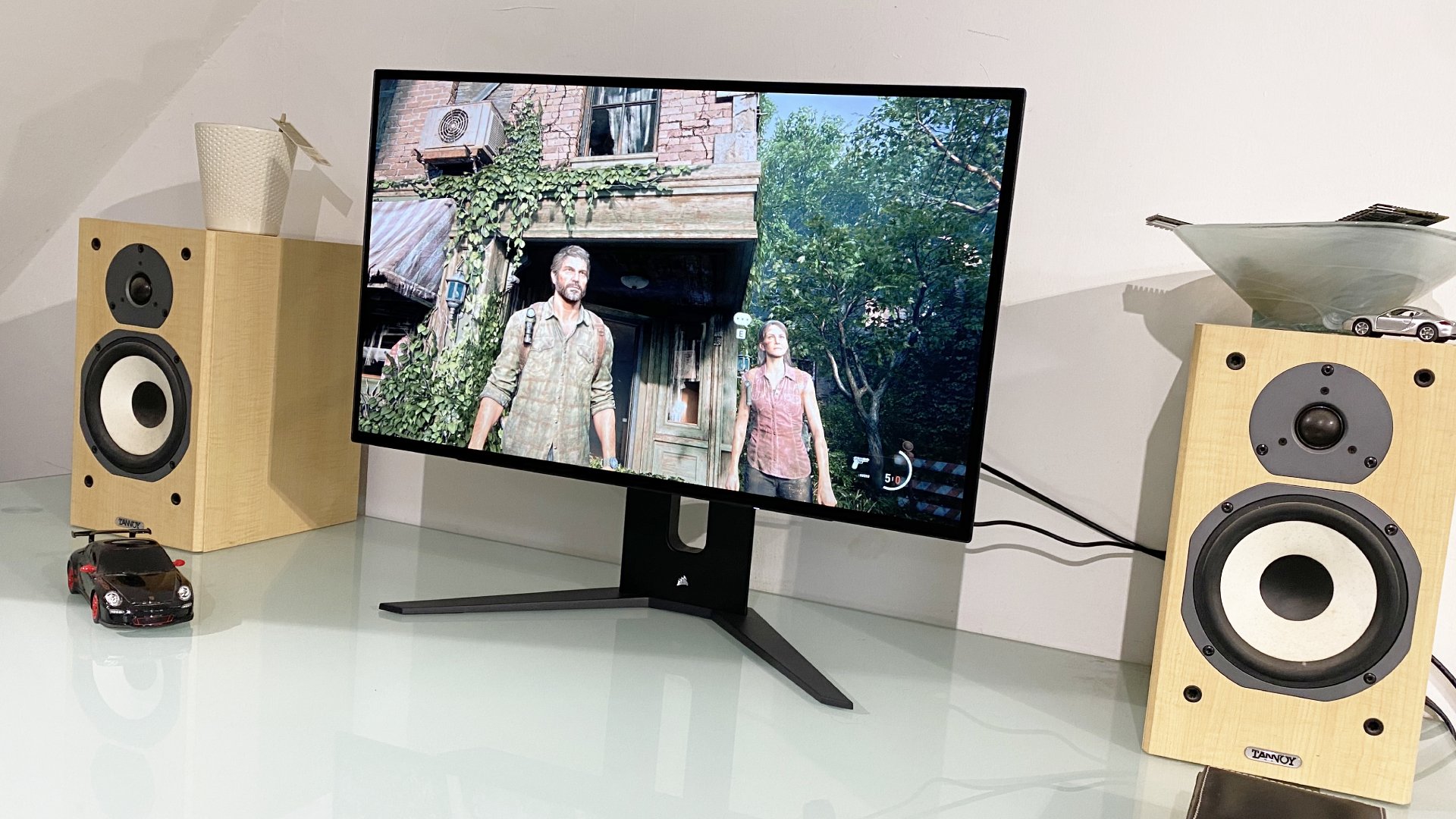
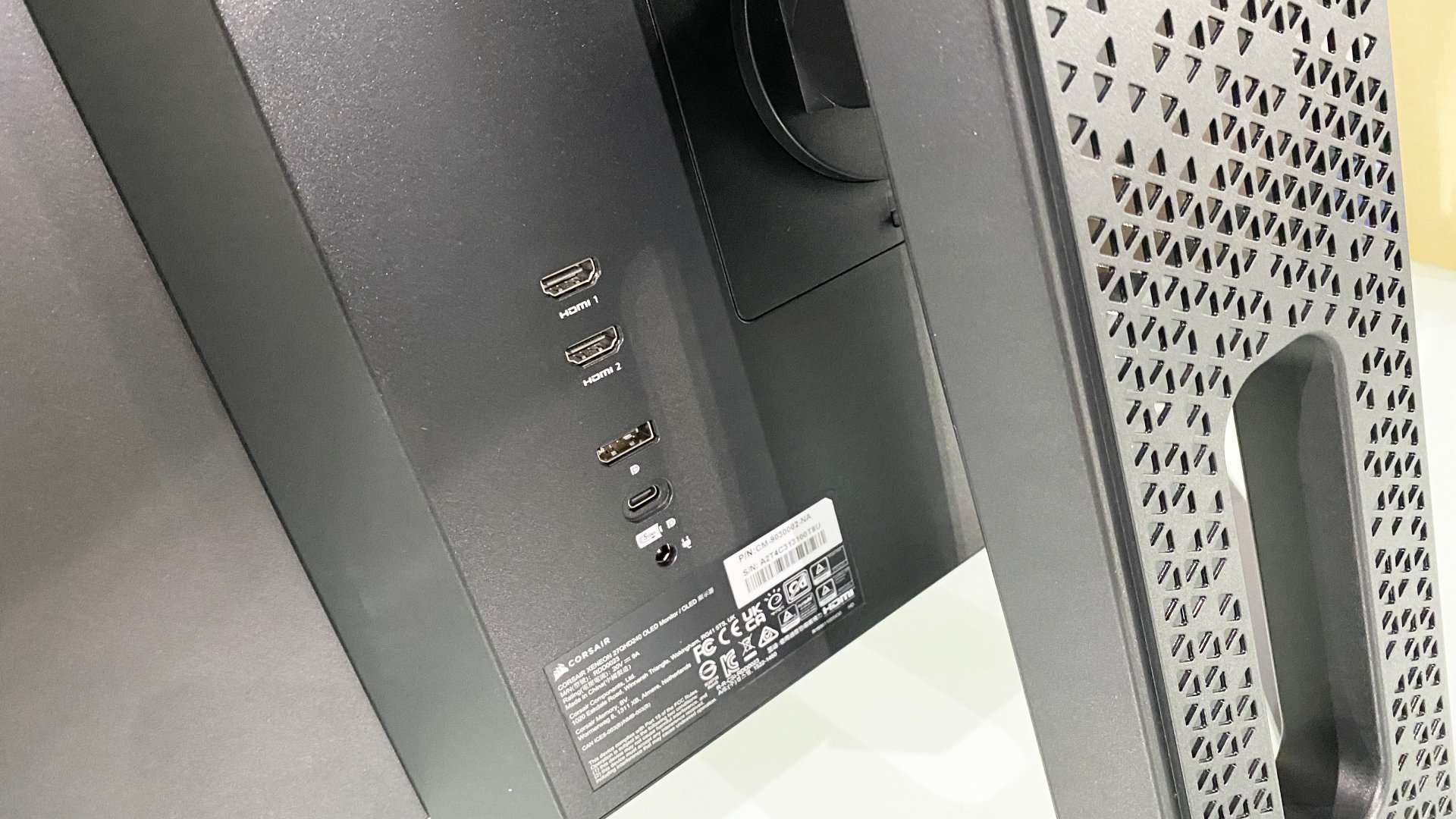


✅ You're competitive shooter fan: The 240Hz refresh rate on the Corsair is a perfect match for fast-paced shooters, and that lightning fast pixel response means that any latency isn't going to be down to your display.
✅ You don't spend much time on the desktop: If you're a pure PC gamer and don't really spend your PC time outside your chosen gameworlds, then the lighting issues won't be as distracting.
✅ You want great design: The ultra-thin panel looks great, and the monitor itself has a host of welcome features, such as USB Type-C power and a dedicated USB hub.
❌ You'd prefer a 4K panel: Proper 4K OLEDs at proper PC monitor sizes (27- and 32-inch) are coming in the next year and that makes it a bit of a tougher decision spending $1,000+ on a 1440p screen today.
❌ You want a punchy display: The LG-powered WOLED panel doesn't have the vibrancy or HDR performance of the Samsung QD-OLED screens, making the 34-inch options a better bet.
You get dual HDMI 2.1 ports, Displayport 1.4, USB-C with power delivery and a multi-port USB hub. It's all really well thought out.
The design is very slick, too, with slim bezels and a thin back to the display that gives a sort of floating panel feel. It's a premium product through and through. Oh, and there's a full three-year warranty, which should cover off most people's major concerns regarding burn-in or image retention.
But this 27-inch 1440p subsection of the new OLED gaming monitor market is problematic. First, the LG panel tech used by every example so far, including this Corsair, still has fundamental brightness issues. They're not catastrophic. But they are hard to stomach at this price point.
The same applies to the panel res and pixel density. Some people will happily make that trade off in return for really high frame rates, but for this kind of money, the panel size and resolution feel a bit stingy.
Ultimately that choice is yours. Are you happy with 27 inches and 1440p? We're expecting 27-inch and 32-inch 4K OLED gaming monitors to appear in the next year or so. And we strongly suspect that most people shopping in this elevated section of the monitor market would choose 4K given the option.
So that's what it comes down to with this monitor and its 27-inch brethren. If you bought one, how would you feel if a 27-inch or 32-inch 4K OLED monitor was announced shortly afterwards?
If you'd think, nope, 1440p is still the right choice for me and you're likewise okay with limited full-screen brightness from the LG panel, then all good. The Corsair Xeneon 27QHD240 is otherwise excellent.
Us? We'd either rather wait for a 32-inch 4K OLED or go for one of the brighter, more immersive 34-inch ultrawide options. As good as the Corsair Xeneon 27QHD240 is in many regards, it's just not enough monitor for the money to be absolute top OLED dawg.
Corsair's take on the 27-inch 1440p OLED is beautifully engineered and all the usual LG-powered OLED upsides appear, including warp-speed responses and lovely per-pixel lighting. But so does the inconsistent brightness. And that's a little tricky to accept at this lofty price point.

Jeremy has been writing about technology and PCs since the 90nm Netburst era (Google it!) and enjoys nothing more than a serious dissertation on the finer points of monitor input lag and overshoot followed by a forensic examination of advanced lithography. Or maybe he just likes machines that go “ping!” He also has a thing for tennis and cars.
